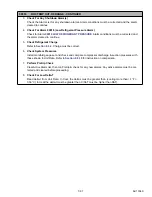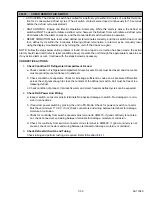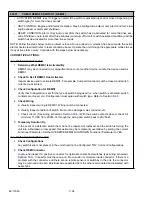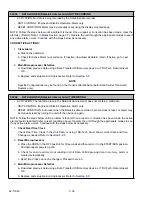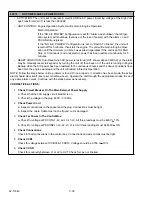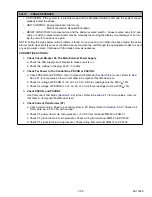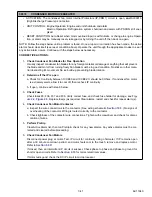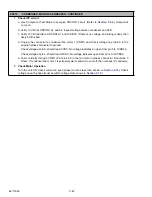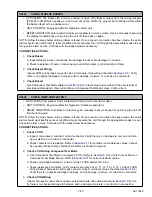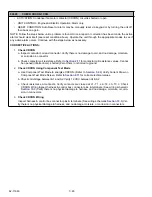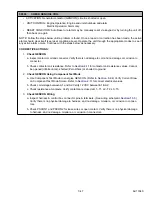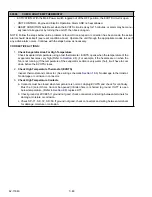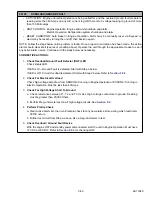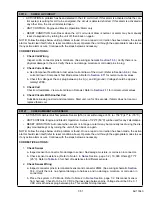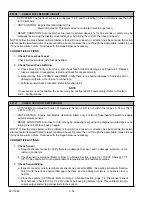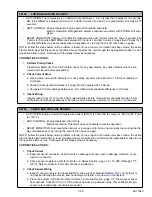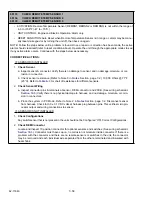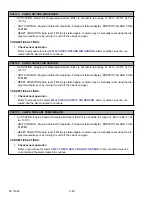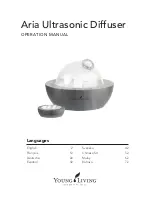
7–45
62-11640
00093
CHECK STARTUP BUZZER
• ACTIVATION: The Buzzer (B) circuit is shorted or open. (The Buzzer output from the microprocessor
[PCM-23 to 3MM15] is negative, so the circuit will not be shorted to ground, but is shorted either within
the Buzzer itself, or to a positive wire.)
• UNIT CONTROL: Engine and Electric Operation: Alarm only.
• RESET CONDITION: Auto reset when Buzzer amp draw is normal, or alarm may be manually reset using
the display mounted keys or by turning the unit off, then back on again.
NOTE: Follow the steps below until a problem is found. Once a repair or correction has been made, the active
alarm should clear itself (refer to reset condition above). Operate the unit through the appropriate modes to see
if any active alarm occurs. Continue with the steps below as necessary.
CORRECTIVE ACTIONS:
1.
Check Buzzer
a. Inspect Buzzer & wire connections. No damage to buzzer. No damage or corrosion.
b. Check resistance of buzzer. Cannot be opened (infinite ohms) or shorted (Zero Ohms).
2.
Check Buzzer Wiring
Inspect PCM sub-harness connector pins & terminals. (See wiring schematic
.) Verify
there is no physical damage to harness, and no damage, moisture, or corrosion in connectors.
3.
Check Buzzer
Use Component Test Mode (Refer to
) to test actual current draw of the circuit. Buzzer
provides audible signal. View current draw in Component Test Mode screen. Verify current.
00094
CHECK COMP CONTACTOR 1
• ACTIVATION: Compressor motor contactor (CCON) circuit is shorted or open.
• UNIT CONTROL: Engine and Electric Operation: Shutdown and alarm.
• RESET CONDITION: Auto Reset or alarm may be manually reset via keypad or by turning the unit off,
then back on again.
NOTE: Follow the steps below until a problem is found. Once a repair or correction has been made, the active
alarm should clear itself (see reset condition above). Operate the unit through the appropriate modes to see if
any active alarm occurs. Continue with the steps below as necessary.
CORRECTIVE ACTIONS:
1.
Check CCON
a. Inspect compressor contactor coil and connector. Verify there is no damage to coil, and no dam-
age, moisture, or corrosion in connector.
b. Check contactor coil resistance. Refer to
for contactor coil resistance values. Cannot
be opened (infinite ohms), shorted (Zero Ohms) or shorted to ground.
2.
Check CCON Using Component Test Mode
a. Use Component Test Mode to energize CCON. (Refer to
). Verify Current Draw on
Component Test Mode Screen. Refer to
for correct electrical values.
b. Check coil voltage between A1 and A2. Verify 12 VDC between A1 & A2.
c. Check resistance at contacts. Verify contacts are closed at L1
−
T1, L2
−
T2, L3
−
T3. 3 Check CCON
Wiring Inspect harness & control box connector pins & terminals. (See schematic
Verify there is no physical damage to harness, and no damage, moisture, or corrosion in connectors.
3.
Check CCON Wiring
Inspect harness & control box connector pins & terminals. (See wiring schematic
). Ver-
ify there is no physical damage to harness, and no damage, moisture, or corrosion in connectors.
Summary of Contents for Vector 8500
Page 23: ...62 11640 1 6 1 3 SAFETY DECALS ...
Page 24: ...1 7 62 11640 62 03958 ...
Page 25: ...62 11640 1 8 ...
Page 26: ...1 9 62 11640 ...
Page 27: ...62 11640 1 10 ...
Page 125: ...62 11640 SECTION 6 MESSAGECENTER PARAGRAPH NUMBER Page 6 1 MESSAGECENTER MESSAGES 6 1 ...
Page 321: ......
Page 322: ......

